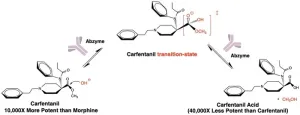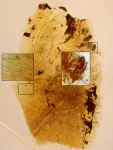(Press-News.org) LA JOLLA, CA—A new therapeutic designed by Scripps Research chemists can alter the molecular structure of the potent opioid carfentanil, inactivating the opioid and reversing a carfentanil overdose. The compound, which is described in an ACS Pharmacology & Translational Science paper published on April 17, 2023, and hasn’t yet been studied in humans, works in a fundamentally different way than existing treatments for opioid overdose.
Carfentanil is up to 10,000 times more potent than morphine and 100 times stronger than fentanyl, making it one of the deadliest opioids. It is typically only used as a tranquilizer for large animals like elephants and rhinoceroses, but it is known to be added to street drugs, ingested accidentally or used in terrorist attacks.
“It has been a big challenge for the field to come up with ways to combat these incredibly strong synthetic opioids like carfentanil,” says senior author Kim Janda, PhD, the Ely R. Callaway, Jr. Professor of Chemistry at Scripps Research. “What is really different about our approach is that this antibody doesn’t just sequester the opioid in the body; it actually inactivates it.”
Opioid drugs—including morphine, codeine, oxycodone, and fentanyl—work by binding to opioid receptors in the brain and spinal cord. At low doses, they can act as painkillers and sedatives. At higher doses, they slow breathing and can cause death. In recent decades, the overuse and misuse of opioids has soared, with more than 71,000 deaths in the U.S. due to synthetic opioids in 2021 alone (CDC).
Overdoses of fentanyl, the most abused opioid, can be treated with naloxone (Narcan). Naloxone works by binding to the brain’s opioid receptors, thereby kicking fentanyl off those receptors and blocking its effect on the body in the process. But carfentanil binds to the receptors more strongly and sticks around the body for longer than fentanyl. Naloxone does not work as well—or works only temporarily—to treat carfentanil overdoses.
In the past, Janda has developed vaccines to sequester opioids away from their receptors in the body. More recently, he wondered whether there was a way to fully inactivate carfentanil and related synthetic opioids. He was particularly interested in a chemical entity embedded within carfentanil’s structure called a methyl ester. He knew that with the right machinery, this methyl ester could be converted to an acid, which he suspected would drastically change the properties of carfentanil and therefore make it unable to bind to the body’s opioid receptors. Molecules that can accelerate a chemical reaction—like the conversion of a methyl ester to an acid—are called catalysts or described as catalytic.
“Before we started designing a catalytic-biologic therapy to carry this reaction out, we had to make sure the drug would actually be inactive and unable to bind receptors without that methyl ester,” says Janda. “Going into this, no one knew whether that was the case.”
In the new work, Janda and his colleagues showed that, indeed, the acid form of carfentanil is about 40,000 times less potent at binding to the opioid receptor compared to the methyl ester form.
Armed with that knowledge, the researchers created a transition-state of carfentanil—partway toward the chemical conversion from a methyl ester to an acid. They then screened libraries of antibodies for one that would bind to this transition-state analogue, helping stabilize it. This kind of molecule, called a catalytic antibody or an “abzyme,” helps encourage a chemical reaction to proceed. Moreover, the better an antibody can bind to the transition state of carfentanil’s ester hydrolysis, the more it will help usher all the carfentanil molecules to convert to an acid.
Janda’s group pinpointed one promising catalytic antibody and showed that it was able to convert carfentanil to the acid form. What is more, treating a mouse respiratory depression model with the catalytic antibody reversed the symptoms of carfentanil overdose, boosting the animals’ breathing and heart rate.
“It was important that we not only showed the biochemistry of this catalytic antibody, but also that it could have translational value,” says Janda. “It is not quite ready for clinical trials, but we believe this proof of concept demonstrating a catalytic antibody degrading a synthetic opioid into an innocuous substance is a promising starting point, and it will help encourage other research groups to examine this line of research.”
The researchers are also planning to test whether the catalytic enzyme works to inactivate other strong opioids, including lofentanil, which is slightly stronger than carfentanil and has a matching methyl ester.
In addition to Janda, authors of the study, “Catalytic Antibody Blunts Carfentanil Induced Respiratory Depression,” are Mingliang Lin, Lisa Eubanks, Nishant Karadkhelkar and Steven Blake of Scripps Research.
This work was supported by the Skaggs Institute for Chemical Biology at Scripps Research.
About Scripps Research
Scripps Research is an independent, nonprofit biomedical institute ranked one of the most influential in the world for its impact on innovation by Nature Index. We are advancing human health through profound discoveries that address pressing medical concerns around the globe. Our drug discovery and development division, Calibr, works hand-in-hand with scientists across disciplines to bring new medicines to patients as quickly and efficiently as possible, while teams at Scripps Research Translational Institute harness genomics, digital medicine and cutting-edge informatics to understand individual health and render more effective healthcare. Scripps Research also trains the next generation of leading scientists at our Skaggs Graduate School, consistently named among the top 10 US programs for chemistry and biological sciences. Learn more at www.scripps.edu.
END
Therapeutic can seek and destroy potent opioid to treat overdoses
Scripps Research chemists developed a new biologic to work against the synthetic opioid carfentanil, which is 100 times more potent than fentanyl.
2023-04-17
ELSE PRESS RELEASES FROM THIS DATE:
No magic number for time it takes to form habits
2023-04-17
Putting on your workout clothes and getting to the gym can feel like a slog at first. Eventually, you might get in the habit of going to the gym and readily pop over to your Zumba class or for a run on the treadmill. A new study from social scientists at Caltech now shows how long it takes to form the gym habit: an average of about six months.
The same study also looked at how long it takes health care workers to get in the habit of washing their hands: an average of a few weeks.
“There is no magic number for habit formation,” says Anastasia Buyalskaya (PhD ’21), now an assistant professor of marketing at HEC Paris. Other authors ...
Cai wins 2023 Gopal K. Shenoy Excellence in Beamline Science Award
2023-04-17
Cai from Argonne’s X-ray Science division recognized for his commitment and advances in beamline science, most notably X-ray diffraction.
Physicist Zhonghou Cai is the 2023 recipient of the Gopal K. Shenoy Excellence in Beamline Science Award. He is a beamline scientist at the U.S. Department of Energy’s (DOE) Argonne National Laboratory.
The annual award recognizes active beamline scientists at the Advanced Photon Source (APS), a DOE Office of Science user facility, for significant contributions to research or instrumentation and support of the beamline user community. The APS Users Office, which grants the award, renamed it ...
AACR: Mutations in three key genes associated with poor outcomes in lung cancer patients treated with KRAS G12C inhibitors
2023-04-17
ABSTRACT: 3431
ORLANDO, Fla. ― A new study led by researchers at The University of Texas MD Anderson Cancer Center discovered that co-occurring mutations in three tumor suppressor genes – KEAP1, SMARCA4 and CDKN2A – are linked with poor clinical outcomes in patients with KRAS G12C-mutant non-small cell lung cancer (NSCLC) treated with the KRAS G12C inhibitors adagrasib or sotorasib.
The findings were presented today at the American Association for Cancer Research (AACR) Annual Meeting 2023 and published in Cancer Discovery, a journal of the AACR. This study, which encompasses the largest cohort to date of patients with KRAS G12C-mutant NSCLC treated with ...
Scientists create powerful, most-accurate tools to research deadliest blood cancer, study says
2023-04-17
New York, NY (April 17, 2023) — Tisch Cancer Center scientists have developed unique models of the deadliest blood cancer, acute myeloid leukemia (AML), creating a transformative resource to study this cancer and eventually its drug response and drug resistance. The models were described in a late-breaking abstract at the annual meeting of the American Association of Cancer Research and simultaneously published in Blood Cancer Discovery, a journal of the American Association for Cancer Research.
These are the first powerful models that are ...
EMBARGOED: Two brain networks are activated while reading, study finds
2023-04-17
When a person reads a sentence, two distinct networks in the brain are activated, working together to integrate the meanings of the individual words to obtain more complex, higher-order meaning, according to a study at UTHealth Houston.
The study, led by Oscar Woolnough, PhD, postdoctoral research fellow in the Vivian L. Smith Department of Neurosurgery with McGovern Medical School at UTHealth Houston, and Nitin Tandon, MD, professor and chair ad interim of the department in the medical school, was published ...
The surprising science behind long-distance bird migration
2023-04-17
AMHERST, Mass. – A team of scientists led by researchers at the University of Massachusetts Amherst has recently made a surprising discovery, with the help of a wind tunnel and a flock of birds. Songbirds, many of which make twice-yearly, non-stop flights of more than 1,000 miles to get from breeding range to wintering range, fuel themselves by burning lots of fat and a surprising amount of the protein making up lean body mass, including muscle, early in the flight. This flips the conventional wisdom ...
Fossils reveal the long-term relationship between feathered dinosaurs and feather-feeding beetles
2023-04-17
New fossils in amber have revealed that beetles fed on the feathers of dinosaurs about 105 million years ago, showing a symbiotic relationship of one-sided or mutual benefit, according to an article published in Proceedings of the National Academy of Sciences of the United States of America today*.
The main amber fragments studied, from the Spanish locality of San Just (Teruel), contain larval moults of small beetle larvae tightly surrounded by portions of downy feathers. The feathers belonged to an unknown theropod dinosaur, either avian (a term referring ...
Sea-level rise in southwest Greenland as a contributor to Viking abandonment
2023-04-17
Vikings occupied Greenland from roughly 985 to 1450, farming and building communities before abandoning their settlements and mysteriously vanishing. Why they disappeared has long been a puzzle, but a new paper from the Department of Earth and Planetary Sciences (EPS) determines that one factor – rising sea level – likely played a major role.
“There are many theories as to what exactly happened” to drive the Vikings from their settlements in Greenland, said Marisa J. Borreggine, lead author of the “Sea-Level ...
SWOG researchers report results in rare gynecologic cancers from DART immunotherapy trial
2023-04-17
Results from the S1609 DART clinical trial, which tested an immunotherapy combination of ipilimumab plus nivolumab in 53 cohorts of patients with rare cancers, are being reported for five cohorts of patients who had rare gynecologic cancers.
In three of those five cohorts – the cohorts for clear cell ovarian cancer; small cell ovarian carcinoma, hypercalcemic type; and non-epithelial ovarian cancer – some patients have shown durable responses to the immunotherapy, including several patients whose complete remissions have now lasted more than three years.
The findings will be presented in three abstracts at the 2023 ...
Can you describe a sensation without feeling it first?
2023-04-17
Blind or colorblind people can describe colors and use expressions like “green with envy” or “feeling blue.” A hearing-impaired person can also say those same vibrant hues are “loud.” But many linguists and cognitive neuroscientists have assumed that somatosensation—touch, pain, pressure, temperature, and proprioception, or the sense of where your body is oriented in space—is fundamental for understanding metaphors that have to do with tactile sensations. Understanding expressions like “she is having a tough time” or “that class was hard,” it was believed, requires previous experience with those sensations to extend ...
LAST 30 PRESS RELEASES:
Drone sampling of whale breath reveals first evidence of potentially deadly virus in Arctic
Roman soldiers defending Hadrian’s Wall infected by parasites, study finds
Pinochet’s prisoners were tormented with music but still found solace in it, a new book reveals
Fertility remains high in rural Tanzania despite access to family planning
AI-assisted device can improve autism care access
Kinetic careers
Uncovering how parasitic plants avoid attacking themselves to improve crop resistance
Nanoparticle vaccine strategy could protect against Ebola and other deadly filoviruses
Study finds brain care score can predict risk of stroke across racial groups
Key lung immune cells can intensify allergic reactions
Do hormones explain why women experience more gut pain?
New materials conduct ions in solids as easily as in liquids
Breakthrough of the Year: Renewable energy begins to eclipse fossil fuel-based sources
LLM use is reshaping scientific enterprise by increasing output, reducing quality and more
Introducing LightGen, a chip for ultra-fast, ultra-efficient generative AI
Astronomers see fireworks from violent collisions around nearby star
ACC/AHA issue new guideline on managing congenital heart disease in adults
Cosmic crash caught on camera
Is talented youth nurtured the wrong way? New study shows: top performers develop differently than assumed
Ants: An untapped resource in the development of antibiotics?
Archaeologists use AI to create prehistoric video game
Mitochondria migrate toward the cell membrane in response to high glucose levels
Tiny viral switch offers hope against drug-resistant bacteria
Most parents aware of early peanut introduction guidelines, but confused about details
HPV vaccine can protect against severe lesions of the vulva and vagina
Virtual care provision and emergency department use among children and youth
Quadrivalent HPV vaccine and high-grade vulvovaginal lesions
Insights into dry eyes gained from stem cell-derived tear glands
Researchers identify 166 human pluripotent stem cell lines available for use in clinical applications
Europa Clipper instrument uniquely observed interstellar comet 3I/ATLAS
[Press-News.org] Therapeutic can seek and destroy potent opioid to treat overdosesScripps Research chemists developed a new biologic to work against the synthetic opioid carfentanil, which is 100 times more potent than fentanyl.




